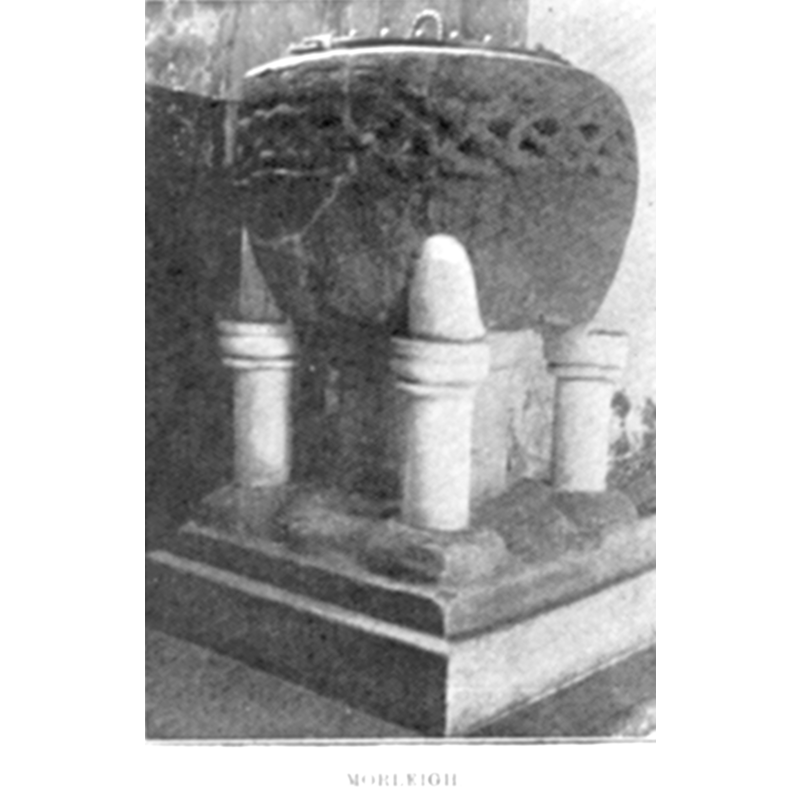Moreleigh / Morleigh

Image copyright © [in the public domain]
PD
Results: 2 records
B01: design element - motifs - guilloche
INFORMATION
FontID: 09462MOR
Object Type: Baptismal Font1
Church/Chapel: Parish Church of All Saints
Church Patron Saints: All Saints
Country Name: England
Location: Devon, South West
Directions to Site: Located off the A381, 13 km E of Dartmouth
Font Location in Church: Inside the church
Century and Period: 13th century, Transitional / Early English
Cognate Fonts: Similar to the font at St. Enodor, in nearby Cornwall
Font Notes:
Click to view
A baptismal font similar to the one at St. Enodor, in the nearby county [NB: the font at St. Enodor is ornamented with a patterned border and four human heads, one at each corner of the basin]. Described and illustrated in Clarke (1922), who comments on the peculiar four corner shafts arrangement: "These latter are modern, but happily the original thirteenth-century base remains; it is cut all in one piece, and the modern shafts rest in the original sockets. The bowl does not rest squarely on the shafts; probably it never did; three of the capitals are surmounted by clumsy blocks of stone the shape of inverted corbels. The bowl rests against these; its true position on the pillars is shown where one corbel is absent. This characteristic occurs in many Cornish fonts, whose corner shafts are surmounted by masks which rest against the side of the bowl and frame without supporting it. It is found in elaborate fonts like St. Stephen in Brannel, Bodmin, St. Wenn and St. Roche; in plainer fonts at St. Ewe and St. Cuby, and many more; but the font which most resembles Morleigh is that of St. Enoder. The bowl of Morleigh font has been patched with new stone, and the plait reproduced; not so accurately as to deceive. Another Cornish feature which presents itself in quite late examples is the mask in many instances in Norman fonts, especially in places near the Cornish border. So it is not surprising to find masks on the late thirteenth-century font at Braunton, but one would hardly expect to meet them at Stodleigh, where they adorn the shaft, while the bowl is plain." Hugh R. Watkin's 'Morleigh [sic] and the family of De Fissacre', in Dev. & Cor. N. & Q., 13: 5 (1925): 226-231, describes the font as "unique in Devon, but similar to St Enodor, Cornwall" [cf. Index entry for St. Enoder/Enodor]. Noted in Pevsner (1952): "Font. Circular, Norman, with one frieze of two intertwined wavy lines."
MEDIUM AND MEASUREMENTS
Material: stone
Font Shape: hemispheric (mounted)
Basin Interior Shape: round
Basin Exterior Shape: round
Rim Thickness: 8.5 cm [calculated]
Diameter (inside rim): 47.5 cm*
Diameter (includes rim): 65 cm*
Basin Depth: 26.25 cm*
Basin Total Height: 43.75 cm*
Height of Central Column: 25 cm*
Font Height (less Plinth): 75 cm*
Notes on Measurements: * [measurements given in inches in Clarke (1922: 223)]
REFERENCES
Clarke, Kate M., "The baptismal fonts of Devon -- Part IX", 54, Report and Transactions of the Devonshire Association for the Advancement of Science, Literature and Art, 1922, pp. 216-223; p. [216]-217, 222, 223 and fig. 2 (opp. p. [216])
Watkin, Hugh R., "Morleigh and the family of De Fissacre", 13, 5, Devon and Cornwall Notes & Queries, 1925, pp. 226-231; p. 226-231